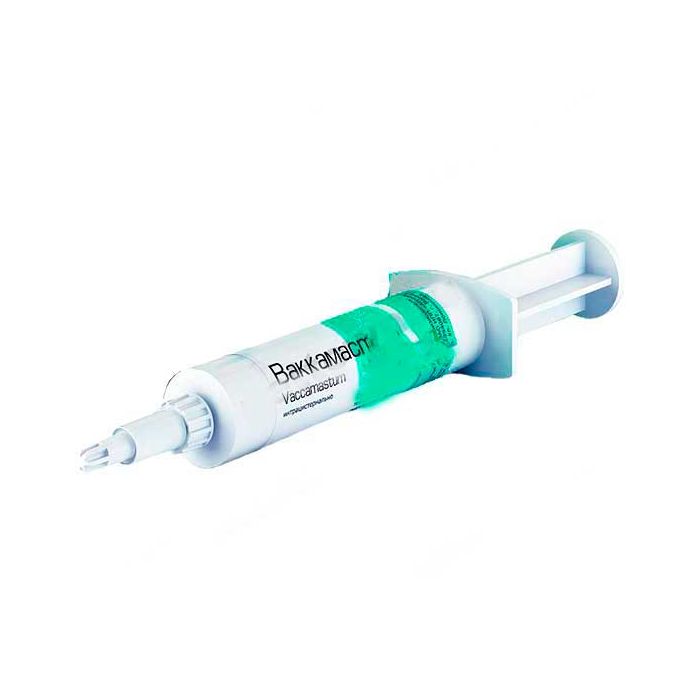Vaccamast syringe tube 10ml
DESCRIPTION
Vaccamast - used to treat mastitis in cows during lactation.
COMPOSITION
1.0 ml contains 6.6 mg of dioxidine (hydroxymethylquinoxalindioxide), 28.8 mg of lincomycin hydrochloride and 0.88 mg of prednisolone as active ingredients, and as auxiliary substances: 8.8 mg of monoglycerides, 26.5 mg of emulsifier ' Ryken DMG type P (V) 'and petroleum jelly oil - up to 1 ml.
PHARMACOLOGICAL PROPERTIES
Vaccamast belongs to the combined antibacterial drugs.
The combination of active substances included in the composition of the drug provides a wide range of antibacterial activity of the drug, prevents the development of resistance of microorganisms.
Lincomycin hydrochloride belongs to antibacterial drugs from the group of antibiotics-lincosamides; produced by Streptomyces lincolniensis or related actinomycetes. It is active against gram-positive microorganisms (staphylococcus, streptococcus, pneumococcus, etc.), some anaerobes and mycoplasmas.
Lincomycin does not act on gram-negative bacteria, fungi and viruses. The mechanism of bacteriostatic action of lincomycin is associated with the suppression of protein synthesis in microorganisms due to reversible binding to the 50S ribosome subunit and disruption of the formation of peptide bonds.
Dioxidine (hydroxymethylquinoxalindioxide) - 2,3-di- (hydroxymethyl) quinoxaline-1,4-dioxide - is an antibacterial agent from the quinoxaline group, is active against gram-negative and gram-positive microorganisms, has a bactericidal effect. The action of dioxidine is due to damage to the DNA biosynthesis of the microbial cell.
Prednisolone is a synthetic glucocorticosteroid, anti-inflammatory, reduces inflammation and reduces swelling of the udder tissue.
According to GOST 12.1.007-76, Vakkamast belongs to low-hazard substances (hazard class 4). When administered intracisternally into the mammary gland of clinically healthy lactating cows, the drug causes a slight, rapidly passing irritation of the udder tissues.
DOSAGE AND APPLICATION
Vaccamast is injected intracisternally, 10 ml into the affected quarter of the udder once a day: with subclinical mastitis - within 2-3 days; with clinical forms of mastitis - within 3-4 days.
Before the introduction of the drug from the diseased quarter of the udder, the secret is milked out, and the nipple is disinfected with 70% ethyl alcohol.
Wakkamast is heated to 36-39РѕРЎ and shaken before use.
When using a syringe-dispenser, its cannula is tightly pressed against the opening of the nipple canal and the drug is injected. From the vial, the drug is taken with a sterile syringe and injected into the nipple of the affected quarter, the udder using a sterile catheter. After the introduction, a light massage of the udder is carried out from the bottom up.
SPECIAL INSTRUCTIONS
The peculiarities of the action of the drug during its first use and withdrawal have not been established.
Skipping the next dose of the drug should be avoided, as this can lead to a decrease in its therapeutic efficacy. If one dose is missed, the use of the drug is resumed in the same dosage and according to the same scheme.
In the event of allergic reactions, the use of the drug is discontinued and antihistamines and symptomatic drugs are prescribed to the animal.
Slaughter of cows for meat is allowed no earlier than 5 days after the last injection of the drug.
The meat of animals that were forcedly killed before the expiration of the specified period can be used as feed for fur animals.
For food purposes, milk is used no earlier than 5 days after the last administration of Vaccamast, provided that the signs of mastitis, confirmed by mastitis tests, disappear completely.
During treatment and within 5 days after the last use of the drug, milk from the affected quarters is disposed of, and from the rest, it is used after boiling into animal feed.
CONTRAINDICATIONS
A contraindication to the use of Vaccamast is the increased individual sensitivity of the animal to dioxidine and lincomycin.
It is forbidden to use Vakkamast simultaneously with kanamycin, ampicillin, erythromycin, chloramphenicol.
SIDE EFFECTS
When using Vaccamast in accordance with this instruction, side effects and complications in cows, as a rule, are not observed.
SHELF LIFE AND STORAGE
Wakkamast is stored in a closed manufacturer's packaging in a dry, dark place, separately from food and feed, at a temperature of 5 В° C to 20 В° C.
The shelf life of the medicinal product, subject to storage conditions, is 2 years from the date of manufacture.
PACKAGING
Syringe tube 10 ml.
Specifications
Item segment
Not multiple packaging
KolVUP
20
Manufacturer
AgroFarm
Temperature regime
from +5 to +25
Teaser
for the treatment of mastitis in cows during lactation

